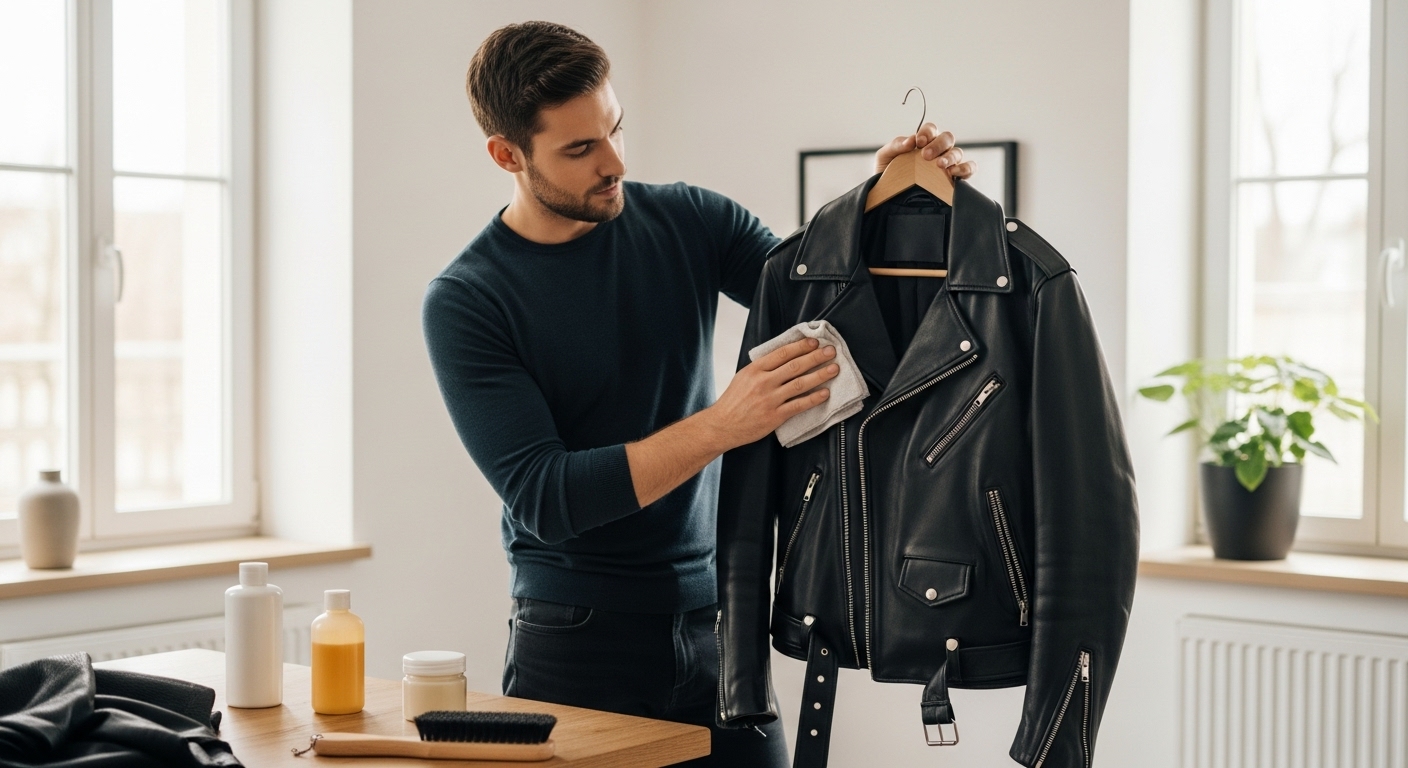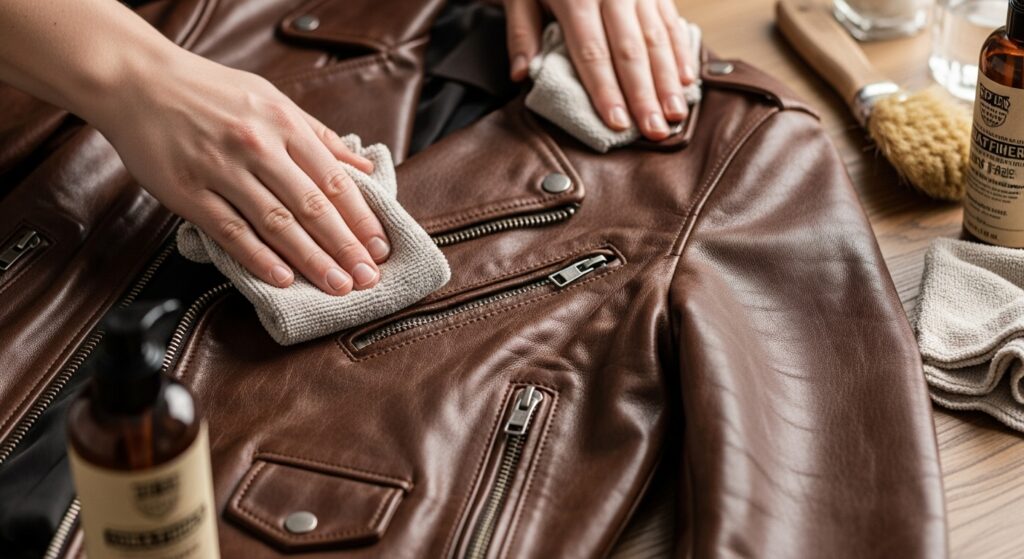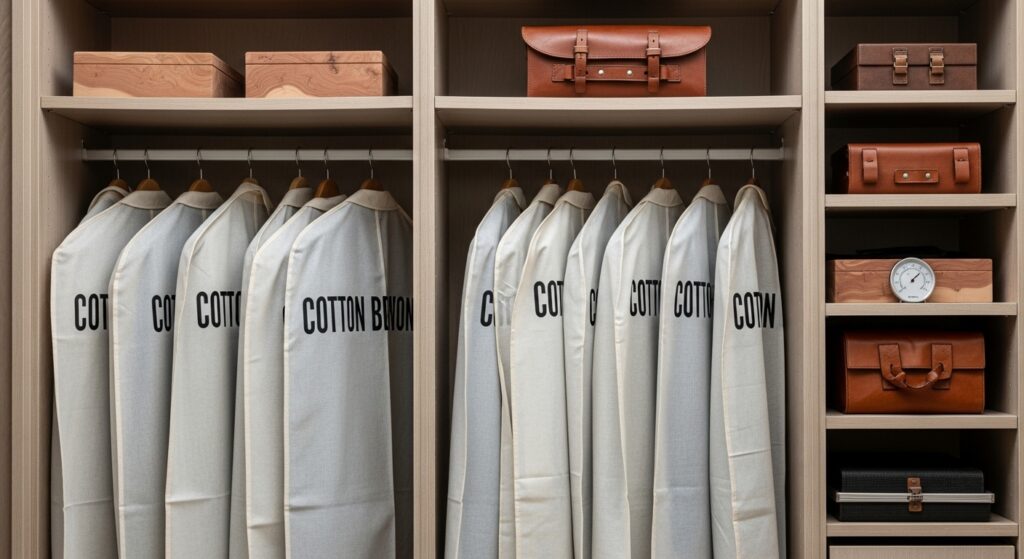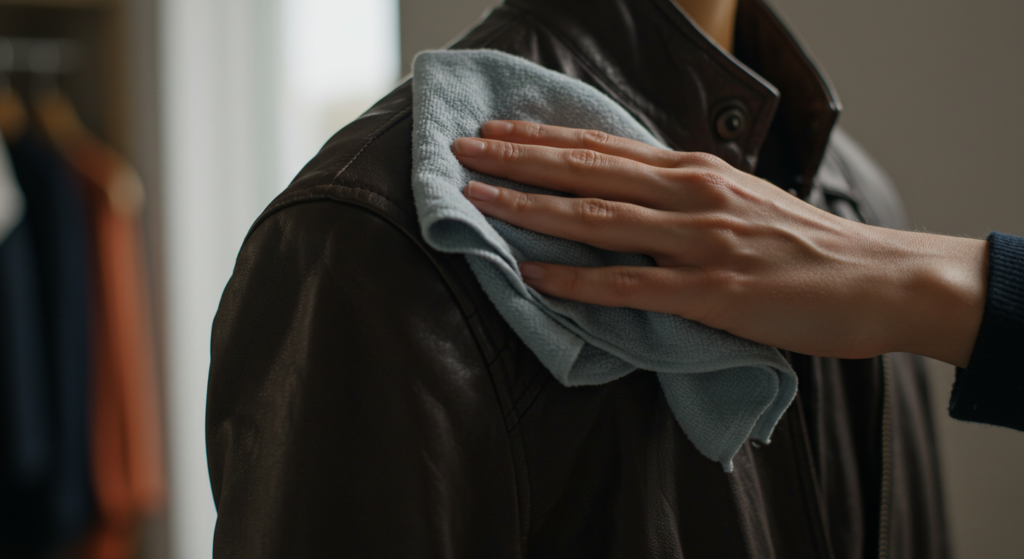How to Take Care of Leather Jacket:

How to Take Care of Leather Jacket: Learn essential steps to maintain your leather jacket.
Understand cleaning, conditioning, and storage tips.
Discover what to avoid to prolong jacket life.
Get expert advice for keeping real leather supple and stylish.
How to Take Care of Leather Jacket: Essential Tips
Owning a leather jacket means committing to its care, so learning how to take care of leather jacket is necessary. Whether it’s a rugged biker style, a smooth bomber, or a classic moto jacket, proper maintenance prevents damage like cracking, fading, and deterioration. Leather, being a natural material, reacts to weather conditions, sunlight, moisture, and environmental pollutants, all of which can harm its quality over time.
A well-maintained leather jacket can last decades, developing a beautiful patina that enhances its character. However, neglected leather becomes brittle and may produce irreversible damage. Understanding proper care techniques is essential for preserving your investment and ensuring your jacket maintains its premium appearance and functionality for years to come.
Why Leather Jacket Care is Crucial
Leather dries out like human skin when exposed to harsh elements. Without regular upkeep, it can become brittle, develop cracks, or suffer discoloration. The natural oils that keep leather supple gradually diminish through wear and environmental exposure. Protecting these oils and avoiding harsh conditions keeps your jacket flexible and looking new for longer.
Different leather types require specific care approaches. Full-grain leather needs different treatment than corrected grain or suede varieties. Understanding your jacket’s leather type helps determine the most effective maintenance routine and appropriate products for optimal results.
Daily Care Habits to Follow
How to take care of leather jacket starts with small, daily actions. After wearing, gently wipe the surface with a soft microfiber cloth to remove dust and oils that can degrade leather over time. This simple habit keeps your jacket clean and protected.
Always hang your jacket on a wide, padded hanger to maintain its shape. Avoid wire hangers or hooks, which can stretch and distort the shoulders. Ensure it’s stored in a well-ventilated area to prevent moisture buildup.
A key rule in how to take care of leather jacket is avoiding sunlight. Prolonged exposure to UV rays dries out leather and causes fading. Store your jacket at room temperature, away from heaters or humid spots, to prevent cracking or warping.
Weekly Inspection Routine
Another step in how to take care of leather jacket is inspecting it weekly. Focus on high-friction areas like cuffs, seams, and collars for signs of dryness or dirt. Brush these areas gently with a leather-safe brush to prevent buildup.
Check hardware like zippers and buttons for corrosion, as metal can stain leather. Spotting minor damage early helps avoid costly repairs. This quick routine keeps your jacket looking sharp and lasting longer.
Monthly Conditioning: Why and How
Leather conditioning is essential to replenish natural oils lost over time. The frequency may vary depending on climate, usage, and leather type, but monthly conditioning provides a good baseline for most jackets. Choose a high-quality conditioner suited for your specific leather type, whether aniline, semi-aniline, or pigmented.

Apply a thin layer using circular motions with a lint-free cloth, working the conditioner into the leather gradually. Allow adequate time for absorption — typically 15-30 minutes — before buffing off excess. Over-conditioning can lead to buildup, making the leather feel sticky, so once a month is usually sufficient unless the jacket endures heavy exposure. Always test new conditioners on a hidden area first to ensure compatibility.
Deep Cleaning Techniques
Leather jackets don’t need frequent washing, but occasional deep cleaning is necessary. Use a damp cloth with mild, pH-neutral soap designed for leather for small stains, taking care not to soak the leather. Work in small sections to avoid water stains and stiffness. Focus on areas like collars and cuffs that collect sweat and oils, as these areas require more frequent attention.
For stubborn stains, consult a professional leather cleaner rather than attempting aggressive methods that might cause irreversible damage. Some stains, particularly oil-based ones, may require specialized treatment. Always allow the jacket to air dry naturally after cleaning, avoiding direct heat sources that can cause cracking.
Waterproofing for Weather Protection
Water can damage leather by causing permanent stains, stiffness, and structural damage. Using a leather-safe waterproofing spray provides crucial protection during rainy seasons and unexpected weather changes. Before applying any waterproofing product, ensure your jacket is clean and completely dry.
Always test on a small hidden patch first to check for adverse reactions or color changes, then apply the spray evenly in thin coats following manufacturer instructions. Reapply every few months, depending on wear and environmental exposure. Remember that waterproofing makes leather water-resistant, not completely waterproof, so avoiding prolonged exposure to heavy rain remains advisable.
Proper Storage Practices
Proper storage significantly extends your leather jacket’s lifespan. When not in use, store your jacket in a breathable garment bag made from cotton or canvas, avoiding plastic covers that trap moisture and can promote mold growth. Never fold the jacket, as this creates permanent creases that are difficult to remove.
Keep it in a cool, dry environment with stable temperature and humidity levels. Closets should have adequate ventilation to prevent stagnant air that encourages mold development. Cedar blocks can help absorb excess moisture without using harsh chemicals.

Common Mistakes to Avoid
Several common mistakes can permanently damage leather jackets. Avoid harsh household cleaners, bleach, ammonia, or alcohol-based products, which can strip natural oils and cause discoloration or cracking. Never use direct heat like hairdryers, radiators, or direct sunlight to dry wet leather, as rapid drying causes severe cracking and shrinkage.
If your jacket gets wet, blot excess moisture gently and allow it to air dry naturally at room temperature. If mold or mildew appears, address it immediately with leather-safe antimicrobial products, as delayed treatment allows spores to penetrate deeper into the leather.
Softening a Stiff Leather Jacket
New leather jackets often feel stiff and uncomfortable initially. The best way to soften them is through natural wear combined with gentle conditioning. Regular movement helps break in the leather fibers naturally while maintaining structural integrity. Using leather oils sparingly and working the leather by bending the arms and body gently helps soften it without darkening the surface.
Patience is key, as rushing this process with excessive oils or harsh methods can cause damage. The natural breaking-in process creates the most authentic and long-lasting results.
Pros and Cons of How TO Take care Of Leather Jacket
Taking care of your leather jacket has clear benefits — it extends its lifespan, keeps its appearance fresh, and saves money by avoiding premature replacement. However, it requires specific products and consistent time investment. A well-cared-for leather jacket can last decades with proper maintenance.
Frequently Asked Questions
How do I know when my leather jacket needs conditioning? If your jacket feels dry, rough, or looks dull, it’s time to condition it.
Can I use coconut or olive oil to soften leather? No, these oils can clog pores and discolor leather. Always use leather-specific conditioners.
Final Thoughts
Consistency is key when caring for your leather jacket. By following these simple but effective steps, you can keep your jacket looking its best for many years. High-quality leather deserves proper maintenance to retain its premium feel and appearance that makes it a timeless wardrobe staple.




